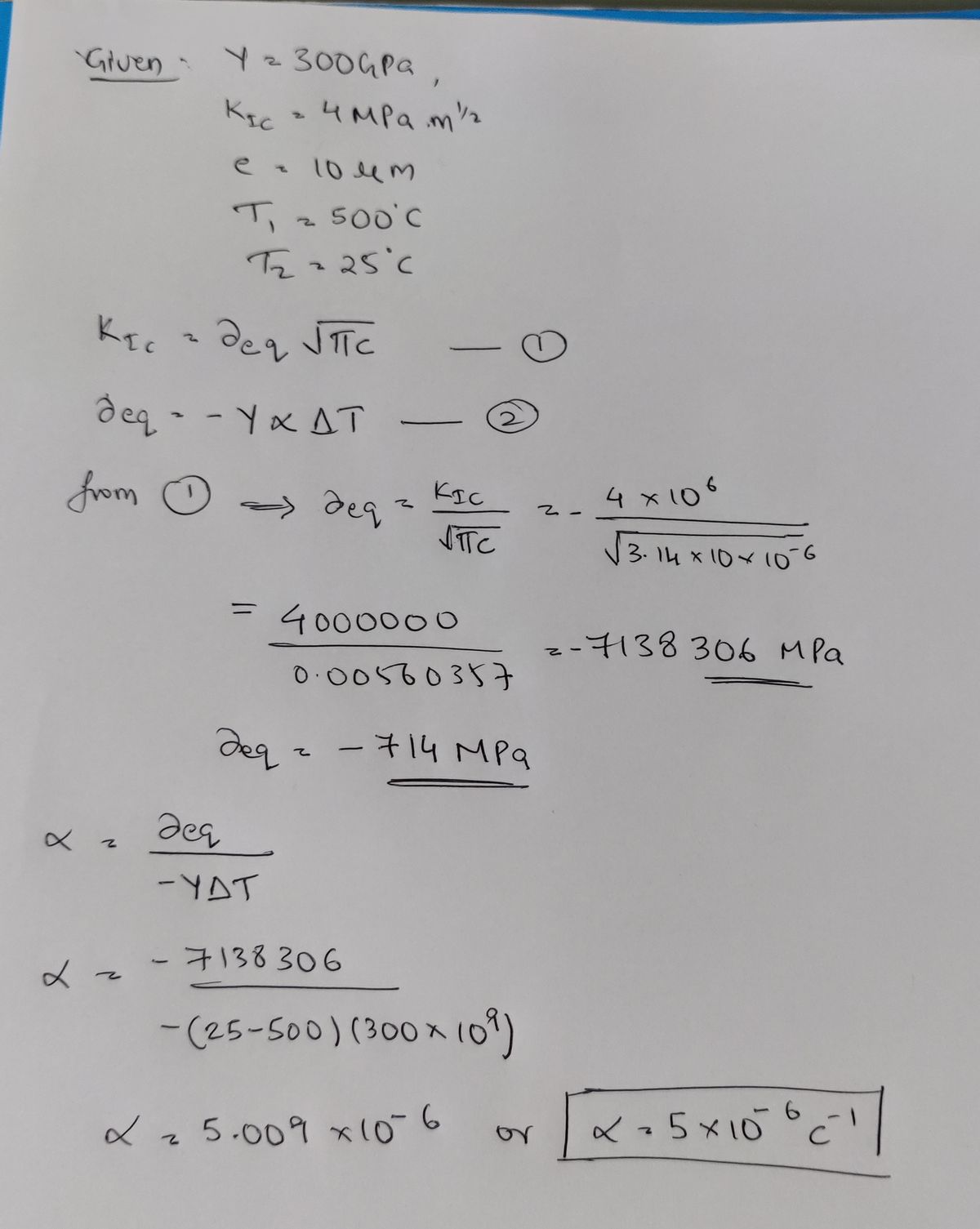
Elements Of Electromagnetics
7th Edition
ISBN: 9780190698614
Author: Sadiku, Matthew N. O.
Publisher: Oxford University Press
expand_more
expand_more
format_list_bulleted
Question
A ceramic component with Young’s modulus of 300 GPa and a KIc of 4 MPa.m1/2 is to survive a water quench from 500°C to room temperature of 25°C. If the largest flaw in that material is on the order of 2 μm, what is the maximum value of thermal expansion coefficient (α) for this ceramic required to survive the quench? Assume that there are 20 flaws of 2 μm size. Poisson ratio of the ceramic material is 0.25.
Expert Solution
arrow_forward
Step 1

Trending nowThis is a popular solution!
Step by stepSolved in 2 steps with 1 images

Knowledge Booster
Learn more about
Need a deep-dive on the concept behind this application? Look no further. Learn more about this topic, mechanical-engineering and related others by exploring similar questions and additional content below.Similar questions
- The yield strength for an alloy that has an average grain diameter of 5.2 x 102 mm is 110 MPa. At a grain diameter of 6.3 x 103 mm, the yield strength increases to 251 MPa. At what grain diameter, in mm, will the yield strength be 222 MPa? d = mmarrow_forwardThe yield point for a brass alloy that has an average grain diameter of 50 micrometers is 120 MPa.arrow_forwardUsing the equation Kica, plot the fracture stress (MPa) for aluminum alloy 7075-T651 versus surface crack size a (mm) for a values from 0.2 mm to 2.0 mm. What is the minimum size surface crack that will cause catastrophic failure?arrow_forward
- NEED AN ANSWER ASAPAn aircraft component is to be fabricated from an aluminum alloy that has a plane strain fracture toughness of 45 MPa m and a yield strength of 500 MPa. It has been determined that fracture results at a stress of 250 MPa when the maximum internal crack length is 9 mm. For this same component and alloy, determine critical internal crack length that will result to fracture if the design stress is three-fourth of the yield strength. If the available flaw detection apparatus has a resolution limit of 3 mm, will the crack in (1) be detected? Why or why not? Show complete solutionarrow_forwardMaterial Science - please helparrow_forward
arrow_back_ios
arrow_forward_ios
Recommended textbooks for you
 Elements Of ElectromagneticsMechanical EngineeringISBN:9780190698614Author:Sadiku, Matthew N. O.Publisher:Oxford University Press
Elements Of ElectromagneticsMechanical EngineeringISBN:9780190698614Author:Sadiku, Matthew N. O.Publisher:Oxford University Press Mechanics of Materials (10th Edition)Mechanical EngineeringISBN:9780134319650Author:Russell C. HibbelerPublisher:PEARSON
Mechanics of Materials (10th Edition)Mechanical EngineeringISBN:9780134319650Author:Russell C. HibbelerPublisher:PEARSON Thermodynamics: An Engineering ApproachMechanical EngineeringISBN:9781259822674Author:Yunus A. Cengel Dr., Michael A. BolesPublisher:McGraw-Hill Education
Thermodynamics: An Engineering ApproachMechanical EngineeringISBN:9781259822674Author:Yunus A. Cengel Dr., Michael A. BolesPublisher:McGraw-Hill Education Control Systems EngineeringMechanical EngineeringISBN:9781118170519Author:Norman S. NisePublisher:WILEY
Control Systems EngineeringMechanical EngineeringISBN:9781118170519Author:Norman S. NisePublisher:WILEY Mechanics of Materials (MindTap Course List)Mechanical EngineeringISBN:9781337093347Author:Barry J. Goodno, James M. GerePublisher:Cengage Learning
Mechanics of Materials (MindTap Course List)Mechanical EngineeringISBN:9781337093347Author:Barry J. Goodno, James M. GerePublisher:Cengage Learning Engineering Mechanics: StaticsMechanical EngineeringISBN:9781118807330Author:James L. Meriam, L. G. Kraige, J. N. BoltonPublisher:WILEY
Engineering Mechanics: StaticsMechanical EngineeringISBN:9781118807330Author:James L. Meriam, L. G. Kraige, J. N. BoltonPublisher:WILEY

Elements Of Electromagnetics
Mechanical Engineering
ISBN:9780190698614
Author:Sadiku, Matthew N. O.
Publisher:Oxford University Press

Mechanics of Materials (10th Edition)
Mechanical Engineering
ISBN:9780134319650
Author:Russell C. Hibbeler
Publisher:PEARSON

Thermodynamics: An Engineering Approach
Mechanical Engineering
ISBN:9781259822674
Author:Yunus A. Cengel Dr., Michael A. Boles
Publisher:McGraw-Hill Education

Control Systems Engineering
Mechanical Engineering
ISBN:9781118170519
Author:Norman S. Nise
Publisher:WILEY

Mechanics of Materials (MindTap Course List)
Mechanical Engineering
ISBN:9781337093347
Author:Barry J. Goodno, James M. Gere
Publisher:Cengage Learning

Engineering Mechanics: Statics
Mechanical Engineering
ISBN:9781118807330
Author:James L. Meriam, L. G. Kraige, J. N. Bolton
Publisher:WILEY